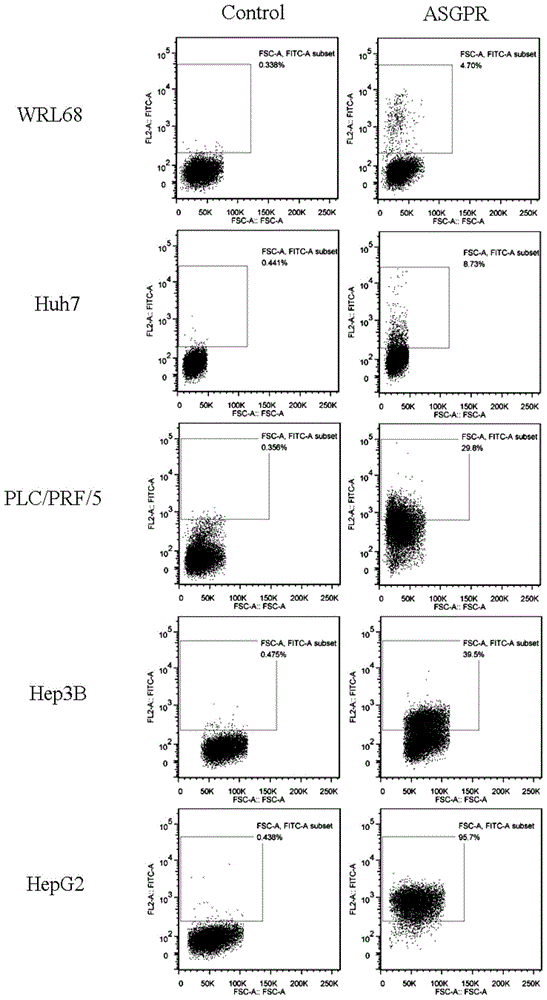Human asialoglycoprotein receptor (ASGPR) monoclonal antibody as well as preparation method and application thereof
A sialoglycoprotein and monoclonal antibody technology, applied in the biological field, can solve problems such as unsatisfactory clinical applications and limited scope of application of antibodies
- Summary
- Abstract
- Description
- Claims
- Application Information
AI Technical Summary
Problems solved by technology
Method used
Image
Examples
Embodiment 1
[0078] Embodiment 1, the preparation of monoclonal antibody
[0079]The ASGPR cDNA (the ASGPR fragment encoding the amino acid sequence such as SEQ ID NO: 1) was obtained by RT-PCR amplification, and the pGEX-4T-1 plasmid (purchased from Invitrogen, USA) was used as a vector, and inserted into the BamHI and EcoRI positions of the vector In the point, the ASGPR expression recombinant vector with GST tag was constructed, transformed into E.coli BL21 competent cells, screened and cultured, induced by isopropylthiogalactoside (IPTG), purified by GST affinity column, 12% SDS-PAGE detection fusion protein expression.
[0080] SQNSQLQEELRGLRETFSNFTASTEAQVKGLSTQGGNVGRKMKSLESQLEKQQKDLSEDHSSLLLHVKQFVSDLRSLSCQMAALQGNGSERTCCPVNWVEHERSCYWFSRSGKAWADADNYCRLEDAHLVVVTSWEEQKFVQHHIGPVNTWMGLHDQNGPWKWVDGTDYETGFKNWRPEQPDDWYGHGLGGGEDCAHFTDDGRWNDDVCQRPYRWVCETELDKASQEPPLL(SEQ ID NO:1)
[0081] Mouse immunization, cell fusion, screening of positive hybridoma cell clones, ascites production, and antibo...
Embodiment 2
[0083] Embodiment 2, the detection of monoclonal antibody
[0084] ① Identification of monoclonal antibody subclasses
[0085] According to the instructions of the monoclonal antibody subclass identification kit.
[0086] As a result, it was determined that the monoclonal antibody of the present invention was of the IgG1 subtype.
[0087] ②ELISA
[0088] According to conventional ELISA method.
[0089] ③Western blot
[0090] Follow routine immunoblotting methods.
[0091] ④ Flow cytometry (FACS)
[0092] Prepare human liver cell line WRL68 and human liver cancer cell lines Hep3B, Huh7, HepG2, PLC / PRF / 5 (the above cell lines were purchased from Shanghai Cell Bank, Chinese Academy of Sciences). The expression of ASGPR in some cell lines has been reported [Park JH, Cho EW, Shin SY, Lee YJ, Kim KL. Detection of the asialoglycoprotein receptor on cell lines of extrahepatic origin. Biochem Biophys Res Commun, 1998, 244: 304- 311].
[0093] Routinely cultivate the above cell ...
Embodiment 3
[0107] Example 3. Isolation and Identification of Circulating Hepatoma Cells Using Monoclonal Antibodies
[0108] Main materials: 5mL peripheral blood of liver cancer patient volunteers, anticoagulated with EDTA. Ficoll-Paque Plus, available from GE Healthcare. The mouse anti-human ASGPR monoclonal antibody (IgG1) of the present invention. Magnetic separator, anti-Mouse IgG1 MicroBeads, MS magnetic separation column, 30 μm filter, CK3-6H5 (antibody against epithelial tissue-derived tumor cells) were all purchased from Miltenyi, Germany. 400R desktop centrifuge (with cytocentrifuge smear attachment), purchased from Heraeus, Germany. Polylysine slides were purchased from Fujian Maixin Company. SP two-step immunohistochemistry kit was purchased from Fuzhou Maixin Biotechnology Company. PBS washing solution (containing 2mM EDTA and 0.5%BSA) was self-prepared.
[0109] step:
[0110] (A) Ficoll separation of peripheral blood mononuclear cells
[0111] 1) Mix 5mL EDTA antico...
PUM
 Login to View More
Login to View More Abstract
Description
Claims
Application Information
 Login to View More
Login to View More - R&D
- Intellectual Property
- Life Sciences
- Materials
- Tech Scout
- Unparalleled Data Quality
- Higher Quality Content
- 60% Fewer Hallucinations
Browse by: Latest US Patents, China's latest patents, Technical Efficacy Thesaurus, Application Domain, Technology Topic, Popular Technical Reports.
© 2025 PatSnap. All rights reserved.Legal|Privacy policy|Modern Slavery Act Transparency Statement|Sitemap|About US| Contact US: help@patsnap.com



